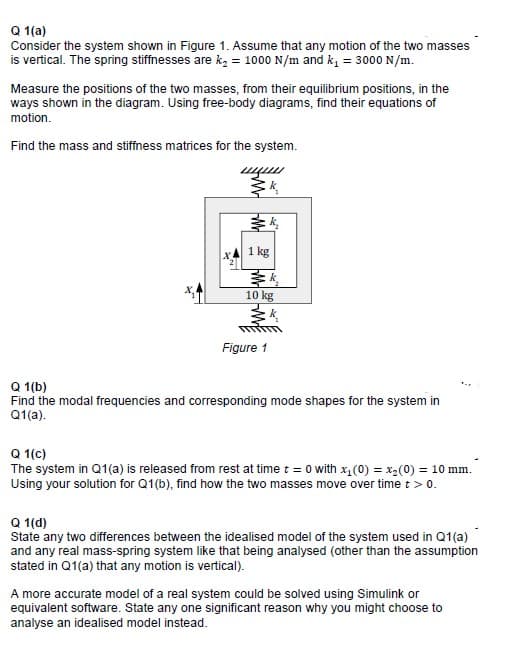Q 1(a) Consider the system shown in Figure 1. Assume that any motion of the two masses is vertical. The spring stiffnesses are k, = 1000 N/m and k, = 3000 N/m. Measure the positions of the two masses, from their equilibrium positions, in the ways shown in the diagram. Using free-body diagrams, find their equations of motion. Find the mass and stiffness matrices for the system. 1 kg 10 kg Figure 1
Q 1(a) Consider the system shown in Figure 1. Assume that any motion of the two masses is vertical. The spring stiffnesses are k, = 1000 N/m and k, = 3000 N/m. Measure the positions of the two masses, from their equilibrium positions, in the ways shown in the diagram. Using free-body diagrams, find their equations of motion. Find the mass and stiffness matrices for the system. 1 kg 10 kg Figure 1
Elements Of Electromagnetics
7th Edition
ISBN:9780190698614
Author:Sadiku, Matthew N. O.
Publisher:Sadiku, Matthew N. O.
ChapterMA: Math Assessment
Section: Chapter Questions
Problem 1.1MA
Related questions
Question
please ans a

Transcribed Image Text:Q 1(a)
Consider the system shown in Figure 1. Assume that any motion of the two masses
is vertical. The spring stiffnesses are kz = 1000 N/m and k, = 3000 N/m.
Measure the positions of the two masses, from their equilibrium positions, in the
ways shown in the diagram. Using free-body diagrams, find their equations of
motion.
Find the mass and stiffness matrices for the system.
1 kg
10 kg
Figure 1
Q 1(b)
Find the modal frequencies and corresponding mode shapes for the system in
Q1(a).
Q 1(c)
The system in Q1(a) is released from rest at time t = 0 with x, (0) = x2(0) = 10 mm.
Using your solution for Q1(b), find how the two masses move over time t> 0.
Q 1(d)
State any two differences between the idealised model of the system used in Q1(a)
and any real mass-spring system like that being analysed (other than the assumption
stated in Q1(a) that any motion is vertical).
A more accurate model of a real system could be solved using Simulink or
equivalent software. State any one significant reason why you might choose to
analyse an idealised model instead.
Expert Solution
This question has been solved!
Explore an expertly crafted, step-by-step solution for a thorough understanding of key concepts.
This is a popular solution!
Trending now
This is a popular solution!
Step by step
Solved in 2 steps with 2 images

Knowledge Booster
Learn more about
Need a deep-dive on the concept behind this application? Look no further. Learn more about this topic, mechanical-engineering and related others by exploring similar questions and additional content below.Recommended textbooks for you

Elements Of Electromagnetics
Mechanical Engineering
ISBN:
9780190698614
Author:
Sadiku, Matthew N. O.
Publisher:
Oxford University Press

Mechanics of Materials (10th Edition)
Mechanical Engineering
ISBN:
9780134319650
Author:
Russell C. Hibbeler
Publisher:
PEARSON

Thermodynamics: An Engineering Approach
Mechanical Engineering
ISBN:
9781259822674
Author:
Yunus A. Cengel Dr., Michael A. Boles
Publisher:
McGraw-Hill Education

Elements Of Electromagnetics
Mechanical Engineering
ISBN:
9780190698614
Author:
Sadiku, Matthew N. O.
Publisher:
Oxford University Press

Mechanics of Materials (10th Edition)
Mechanical Engineering
ISBN:
9780134319650
Author:
Russell C. Hibbeler
Publisher:
PEARSON

Thermodynamics: An Engineering Approach
Mechanical Engineering
ISBN:
9781259822674
Author:
Yunus A. Cengel Dr., Michael A. Boles
Publisher:
McGraw-Hill Education

Control Systems Engineering
Mechanical Engineering
ISBN:
9781118170519
Author:
Norman S. Nise
Publisher:
WILEY

Mechanics of Materials (MindTap Course List)
Mechanical Engineering
ISBN:
9781337093347
Author:
Barry J. Goodno, James M. Gere
Publisher:
Cengage Learning

Engineering Mechanics: Statics
Mechanical Engineering
ISBN:
9781118807330
Author:
James L. Meriam, L. G. Kraige, J. N. Bolton
Publisher:
WILEY